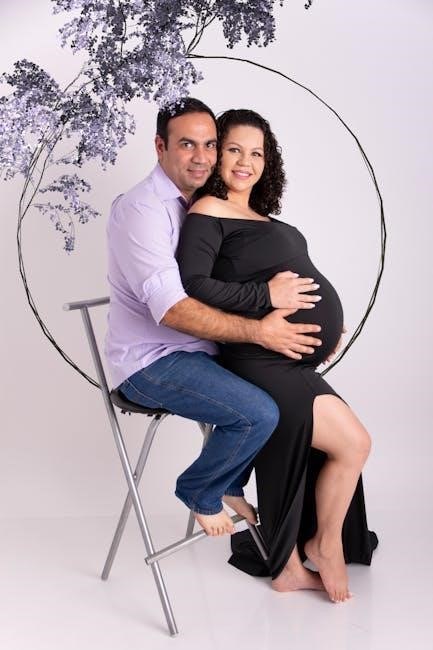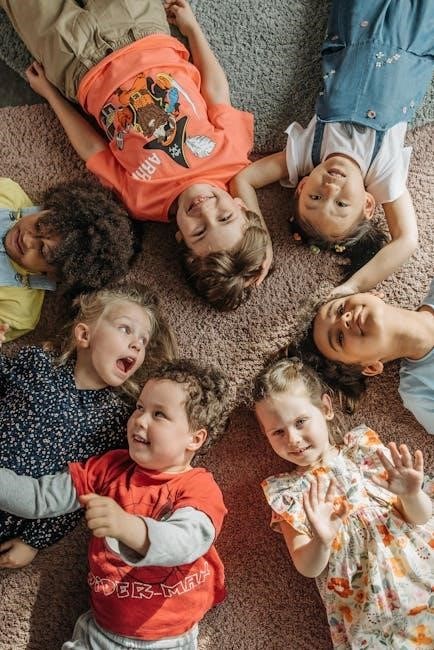relationship circles pdf

Relationship circles are a visual tool for mapping social connections, categorizing relationships based on emotional closeness and interaction frequency. This structured approach helps individuals analyze their networks, enhancing self-awareness and communication while identifying support systems and fostering personal growth.
1.1 Definition and Purpose
A Relationship Circle is a visual tool designed to map and categorize the various relationships in an individual’s life. It organizes connections based on emotional closeness, trust, and frequency of interaction, creating a structured diagram that reflects social networks. The purpose of this tool is to help individuals gain clarity about their relationships, identify support systems, and establish boundaries. By visually representing relationships, it becomes easier to recognize patterns, strengths, and areas for improvement. The Relationship Circle is often divided into concentric circles, with the innermost representing intimate relationships like family and close friends, while outer circles include acquaintances and professional contacts. This framework aids in understanding the dynamics of personal and professional interactions, promoting self-awareness and intentional relationship management. It is widely used in personal development, counseling, and social skills training to foster healthier and more balanced connections. The ultimate goal is to empower individuals to nurture meaningful relationships while maintaining appropriate boundaries, leading to emotional well-being and a stronger sense of community.
1.2 Brief History and Evolution
The concept of Relationship Circles has its roots in social network theories and mapping tools developed in the 20th century. Initially, these tools were used in counseling and social work to help individuals visualize their support systems. Over time, the idea evolved into a structured framework for understanding relationship dynamics. The modern concept of Relationship Circles gained prominence with the work of Marsha Forest, Jack Pearpoint, and Judith Snow in the 1990s, particularly through their CIRCLES program. This program aimed to help individuals, especially those with disabilities, map their social connections and build inclusive communities.

The tool has since been adapted for broader use, becoming a popular exercise in personal development, education, and workplace team-building. The digital age has further enhanced its accessibility, with templates and worksheets available online. Today, Relationship Circles are widely recognized as a powerful method for fostering self-awareness, improving communication, and strengthening relationships across various aspects of life.
This evolution reflects the growing understanding of the importance of social connections in personal and professional well-being. By providing a clear and visual way to explore relationships, the Relationship Circle has become an essential tool for individuals seeking to navigate their social worlds more effectively.

Benefits of Mapping Relationship Circles

Mapping Relationship Circles fosters self-awareness, improves communication, and identifies support networks. It helps individuals prioritize relationships, set boundaries, and focus on personal growth. This tool also enhances emotional well-being by visualizing social connections and strengthening meaningful interactions in both personal and professional lives.
2.1 Enhancing Self-Awareness
Mapping Relationship Circles significantly enhances self-awareness by providing a clear visual representation of one’s social network. This tool allows individuals to recognize the depth and complexity of their relationships, identifying who plays a central role in their lives and who may be more peripheral. By categorizing connections into circles such as intimacy, friendship, and acquaintance, individuals can better understand their emotional boundaries and attachment styles. This process encourages introspection, helping people acknowledge patterns in their relationships, such as recurring dynamics or gaps in their support system. Enhanced self-awareness fosters a deeper understanding of personal needs and desires, enabling individuals to make more intentional decisions about nurturing or adjusting their connections. Ultimately, this clarity empowers individuals to cultivate healthier, more fulfilling relationships and align their social interactions with their personal values and goals.

2.2 Improving Communication Skills
Mapping Relationship Circles is an effective way to improve communication skills by providing clarity on how to interact with individuals based on their position in one’s social network. By categorizing relationships into circles such as intimacy, friendship, and acquaintance, individuals can tailor their communication approaches to match the depth of each connection. For example, conversations with those in the inner circles may require vulnerability and emotional openness, while interactions with outer circles might focus on professionalism or casual exchanges. This structured approach helps individuals identify communication patterns, such as over-reliance on certain relationships or under-engagement with others, allowing them to adjust their interactions accordingly. Additionally, the process of creating Relationship Circles encourages active listening and empathy, as individuals must consider the perspectives and needs of those in their network. By understanding the boundaries and expectations associated with each circle, individuals can communicate more effectively, fostering healthier and more meaningful relationships. This tool not only enhances interpersonal connections but also promotes confidence in navigating diverse social dynamics.
2.3 Identifying Support Networks

Mapping Relationship Circles is a powerful way to identify and visualize support networks, providing clarity on who plays a significant role in one’s life. By organizing relationships into distinct circles, individuals can easily recognize the people who offer emotional, practical, or professional support. The inner circles, such as the Circle of Intimacy, highlight close family and friends who serve as anchors, providing unconditional support and trust. The outer circles, including acquaintances and professional contacts, reveal secondary support systems that can be leveraged in specific situations. This tool helps individuals identify gaps in their support networks, such as a lack of close friends or over-reliance on certain relationships. By understanding where their support comes from, individuals can better navigate challenges and build stronger connections. Additionally, Relationship Circles encourage individuals to reflect on the boundaries and expectations within their networks, fostering healthier relationships. This process not only enhances emotional well-being but also equips individuals with the awareness needed to seek help when required, ensuring they are surrounded by a balanced and supportive community. Ultimately, identifying support networks through Relationship Circles empowers individuals to cultivate meaningful connections and maintain a resilient social foundation.
2.4 Promoting Personal Growth
Mapping Relationship Circles is a transformative tool for fostering personal growth by helping individuals gain insights into their social dynamics. By visually organizing relationships into distinct circles, individuals can identify patterns, strengths, and areas for improvement. This process encourages self-reflection, allowing people to evaluate how their connections align with their values and goals. Understanding the distribution of relationships across different circles can reveal imbalances, such as over-reliance on certain individuals or a lack of diverse social interactions. This awareness empowers individuals to make intentional decisions about nurturing or redefining relationships, leading to healthier and more fulfilling connections. Additionally, Relationship Circles highlight opportunities for expanding social networks, whether through forming new friendships or strengthening professional relationships. By regularly assessing and adjusting their circles, individuals can track their progress over time, celebrating growth and addressing challenges. This practice not only enhances emotional resilience but also aligns personal relationships with long-term aspirations, fostering a sense of purpose and direction. Ultimately, Relationship Circles serve as a dynamic guide for cultivating meaningful relationships and achieving personal development.

How to Create a Relationship Circle
Creating a Relationship Circle involves identifying key relationships, categorizing connections, and using tools or templates to map them visually. Start by listing important people, organize them into circles based on emotional closeness, and regularly evaluate and adjust the map to reflect changes in your social connections.
3.1 Identifying Key Relationships
Identifying key relationships is the first step in creating a Relationship Circle. Begin by listing individuals who play significant roles in your life, such as family members, close friends, colleagues, and mentors. Consider their emotional closeness and frequency of interaction. Immediate family and intimate partners typically fall into the innermost circle, serving as anchors. Close friends, who offer trust and support, are also included here. Next, identify acquaintances and professional contacts, placing them in outer circles based on their level of involvement in your life. This process helps visualize your social network, highlighting both strong connections and potential gaps. By evaluating these relationships, you can better understand where to focus efforts to strengthen or expand your support system. This step is crucial for building a clear and effective Relationship Circle, ensuring it accurately reflects your current social landscape.
3.2 Categorizing Connections
Categorizing connections is a foundational step in mapping your Relationship Circle. Start by dividing your relationships into distinct groups based on their emotional closeness and frequency of interaction. The innermost circle typically includes immediate family and intimate partners, who serve as emotional anchors. The next circle might consist of close friends who offer trust and support, followed by acquaintances and professional contacts in outer circles. This hierarchical approach helps visualize the depth and breadth of your social network.
To effectively categorize, consider factors like trust, shared experiences, and the level of vulnerability you feel with each person. For example, those in the inner circle are often those with whom you share personal thoughts and feelings. Outer circles may include colleagues or casual acquaintances with whom interactions are less frequent or deeply personal.
Using tools like templates or worksheets can aid in organizing these connections. By evaluating relationships and placing them in appropriate circles, you gain clarity on your support system and identify areas for potential growth or adjustment. This process fosters a deeper understanding of your social landscape, enabling more intentional relationship management.
3.3 Tools and Templates for Mapping
A variety of tools and templates are available to help individuals map their Relationship Circles effectively. Worksheets and PDF templates can be downloaded for free from platforms like Google Drive or purchased from educational websites. These templates often include concentric circles labeled according to the depth of relationships, such as intimacy, friendship, and acquaintances.
Online resources, such as the Clipart library, offer high-quality Relationship Circles templates that can be customized for personal or professional use. Tools like Canva or PowerPoint allow users to design their own visual representations, adding names, colors, and annotations to make the map more personalized and meaningful.

Some templates include guided instructions, prompting users to reflect on the emotional closeness and frequency of interactions with each person. Additionally, scripts for practicing conversations with different groups can be included to enhance communication skills. Whether using a pre-designed template or creating one from scratch, these tools provide a structured framework for visualizing and analyzing social connections.
Many templates are adaptable, catering to diverse audiences, including students, professionals, and families. They often emphasize the importance of boundaries and support networks, making them a versatile resource for personal growth and relationship management. By leveraging these tools, individuals can create a clear and organized map of their Relationship Circle, fostering greater self-awareness and intentional relationship-building.

3.4 Evaluating and Adjusting Over Time
Evaluating and adjusting Relationship Circles over time is essential for maintaining accurate and meaningful social maps. As relationships evolve, new connections are formed, and others may become more or less significant. Regularly reviewing and updating the circles ensures they remain reflective of current dynamics.
This process involves reflecting on changes in emotional closeness, interaction frequency, and the level of trust or support exchanged. For instance, a colleague might move from the outer circle of acquaintances to the inner circle of friendship, or a family member’s relationship may deepen over time. Adjustments can be made by relocating names within the circles or adding new individuals to the diagram.
Tools like journals or digital apps can aid in tracking these changes systematically. Additionally, discussing the evolving circles with trusted individuals can provide fresh perspectives and insights. By periodically reassessing and refining the Relationship Circle, individuals can better understand their social landscape and make intentional decisions to nurture or redefine connections.
This iterative process fosters personal growth, strengthens relationships, and helps identify gaps or areas where new connections might be beneficial. Over time, the Relationship Circle becomes a dynamic and adaptive tool for navigating life’s social complexities.

Types of Relationship Circles
Relationship circles are categorized into distinct groups based on emotional closeness and interaction levels. Common types include the Circle of Intimacy for closest relationships, Circle of Friendship for trusted acquaintances, and outer circles for professional or casual connections, helping to organize and understand social dynamics effectively.
4.1 Circle of Intimacy
The Circle of Intimacy represents the closest relationships in one’s life, serving as a foundation of trust and emotional support. This innermost circle typically includes immediate family members, partners, and close friends who provide unconditional love and understanding. These individuals are often considered “anchors,” offering stability and comfort during challenging times. The Circle of Intimacy is crucial for personal well-being, as it fosters a sense of belonging and security. By identifying those within this circle, individuals can better nurture these vital connections, ensuring strong emotional bonds. This circle is also where vulnerability and open communication thrive, allowing for deep, meaningful interactions. Regularly evaluating and strengthening these relationships can lead to greater life satisfaction and resilience. Understanding the Circle of Intimacy helps individuals prioritize and invest in the relationships that matter most, creating a supportive network that enriches their lives. This foundational circle plays a pivotal role in overall emotional and mental health, emphasizing the importance of maintaining and cherishing these intimate connections.
4.2 Circle of Friendship
The Circle of Friendship encompasses close friends and confidants who play a significant role in providing emotional support and companionship. These relationships are built on trust, mutual respect, and shared experiences, offering a sense of belonging and connection. Unlike the Circle of Intimacy, friendships in this circle may not involve the same level of vulnerability but are still deeply meaningful. Friends in this circle are often those with whom individuals share personal thoughts, feelings, and experiences, creating a strong bond over time. They provide comfort, advice, and encouragement, acting as a support system during both joyous and challenging moments. Maintaining these friendships requires effort, such as regular communication and shared activities, which help strengthen the connection. The Circle of Friendship also offers opportunities for personal growth, as friends can introduce new perspectives and ways of thinking. By nurturing these relationships, individuals can build a resilient and fulfilling social network. This circle highlights the importance of fostering meaningful connections beyond intimate relationships, contributing to a balanced and enriched life. Recognizing and appreciating these friendships can lead to greater overall satisfaction and well-being.